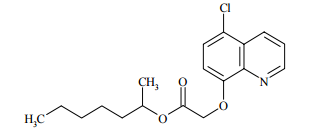CLOQUINTOCET-MEXYL
  Ҫв¶ҫаӯ, ҪвІЭхҘ Ҫв¶ҫаӯ, ҪвІЭхҘ
Introduction: Cloquintocet-mexyl improves cereal crop tolerance to the herbicide clodinafoppropargyl. It is used to control herbicide safener in combination with clodinafoppropargyl for selective control of annual grasses (Alopecurus myosuroides, Avena spp., Lolium spp., Phalaris spp., Poa trivialis, Setaria spp.) in small grain cereals.
CLOQUINTOCET-MEXYL Ҫв¶ҫаӯ, ҪвІЭхҘ
Introduction: Cloquintocet-mexyl improves cereal crop tolerance to the herbicide clodinafoppropargyl. It is used to control herbicide safener in combination with clodinafoppropargyl for selective control of annual grasses (Alopecurus myosuroides, Avena spp., Lolium spp., Phalaris spp., Poa trivialis, Setaria spp.) in small grain cereals.
Common name: Cloquintocet-mexyl
Another name: cloquintocet-1-methylhexyl ester, cloquintocet-1, Cloquintocetmexyl
cloquitocet_mexyl, etc.
Chemical name: (RS)-1-methylhexyl (5-chloroquinolin-8-yloxy)acetate
Empirical formula: C18H22ClNO3
Structural formula:

Mol. Weight: 335.8 g/mol
CAS No.: 99607-70-2
Specifications
Leading Cloquintocet-mexyl supplier
Cloquintocet-mexyl 27 g/L EW
Cloquintocet-mexyl 3.75% WP
Cloquintocet-mexyl 95% TC
Packing:
BULK PACKING
Solid: 25kg/Bag, 25kg/Drum, 50kg/Drum etc.
Liquid: 200L/Drum, 20L/Drum, 10L/Drum ect.
SMALL PACKING
Solid: 1kg/Alu bag, 500g/Alu bag, 200g/Alu bag, 100g/Alu bag, 50g/Alu bag, 15g/Alu bag etc.
Liquid: 5L/Drum, 1L/Bottle, 500ml/Bottle, 250ml/Bottle, 100ml/Bottle, 50ml/Bottle etc.
Customerized packing label
Professional registration
HAZARDS IDENTIFICATION
Hazard statement(s)
H317 (73.45%): May cause an allergic skin reaction.
H319 (11.3%): Causes serious eye irritation.
H332 (25.99%): Harmful if inhaled.
H373 (25.99%): Causes damage to organs through prolonged or repeated exposure. H400 (60.45%): Very toxic to aquatic life.
H410 (87.01%): Very toxic to aquatic life with long lasting effects.
Precautionary statement(s)
P260: Do not breathe dust/fume/gas/mist/vapors/spray.
P261: Avoid breathing dust/fume/gas/mist/vapors/spray.
P264: Wash ... thoroughly after handling.
P271: Use only outdoors or in a well-ventilated area.
P272: Contaminated work clothing should not be allowed out of the workplace.
P273: Avoid release to the environment.
P280: Wear protective gloves/protective clothing/eye protection/face protection.
P302+P352: IF ON SKIN: wash with plenty of water.
P304+P312: IF INHALED: Call a POISON CENTER/doctor/... if you feel unwell.
P304+P340: IF INHALED: Remove person to fresh air and keep comfortable for breathing.
P305+P351+P338: IF IN EYES: Rinse cautiously with water for several minutes. Remove contact lenses if present and easy to do - continue rinsing.
P312: Call a POISON CENTER or doctor/... if you feel unwell.
P314: Get medical advice/attention if you feel unwell.
P321: Specific treatment (see ... on this label).
P333+P313: IF SKIN irritation or rash occurs: Get medical advice/attention.
P337+P313: IF eye irritation persists: Get medical advice/attention.
P363: Wash contaminated clothing before reuse.
P391: Collect spillage.
P501: Dispose of contents/container to ...
Supplemental Hazard Statements: none
MAMMALIAN TOXICOLOGY
Acute toxicity: 1) Acute oral LD50 for rat: >2000 a.i.mg/kg. 2) Acute dermal LD50 for rat: >2000 a.i.mg/kg. 3) Inhalation LC50 (4 h) for rat: >0.935 a.i. mg/L. 4) Non-irritating to skin (rabbits). 5) Slightly-irritating to eyes (rabbits). 6) May cause skin sensitisation (guinea pigs).
NOEL: (2 y) for rats is 4 mg/kg b.w. daily; (18 mo) for mice is 106.5 mg/kg b.w. daily; (1 y) for dogs is 44 mg/kg b.w. daily.
ADI: 0.04 mg/kg b.w./day [UK ACP 1999]
Classification:
EC Risk Classification: Xn - Harmful: R43
ECOTOXICOLOGY
Effect on birds: moderate toxicity to birds, acute oral LD50 for Bobwhite quail is 2000 a.i.mg/kg. Effect on fish: moderate toxicity to fish, acute 96 hour LC50 for Rainbow trout is 76 a.i.mg/L. Effect on aquatic invertebrates: moderate toxicity to aquatic invertebrates, acute 48 hour EC50 for Daphnia magna is 100 a.i.mg/L. Effect on algae: moderate toxicity to algae, acute 72 hour EC50 for Scenedemus subspicatus is 0.53 a.i.mg/L. Effect on honeybees: low toxicity to honeybees, oral acute 48 hour LD50 is >100 a.i.ҰМg/bee. Effect on earthworms: moderate toxicity to earthworms, acute 14 day LC50 for Eisenia foetida is 1000 a.i.mg/kg.
ENVIRONMENTAL FATE
In the loamy sand soil, [14C]cloquintocet-mexyl decreased from an average 98.90% of the applied at 0 days posttreatment to 41.62% at 0.21 days, 11.20% at 1 day and 5.33% at 56 days. In the silt loam soil, [14C]cloquintocet-mexyl decreased from an average 48.16% of the applied at 0 days posttreatment to 23.69% at 0.21 days, 9.26% at 1 day and 1.97% at 56 days. Cloquintocet-mexyl degraded with a DT50 of 0.2 days in both soils using a two-compartment model with MicroCal Origin. The DT50 for the transformation product CGA 153443 was determined to be 5.5 and 9.7 days in the loamy sand and silt loam soils, respectively. At study termination, [14C]residues trapped in the NaOH solution totaled 5.69% of the applied from the loamy sand soil and 13.01% from the silt loam. These residues were characterized as 14CO2, by the study author; no methodology was provided to determine if the identification was definite or assumed. No data were provided on volatile organics were not reported.
Usage: Manufacturers: Syngenta. A herbicide safener used to improve cereal crop tolerance to the herbicide clodinafop-propargyl.
Application: Effective to alopecurus aequalis sobol, wild oat and Annual Bluegrass. Non-effective to broad-leaf weed.
| 






